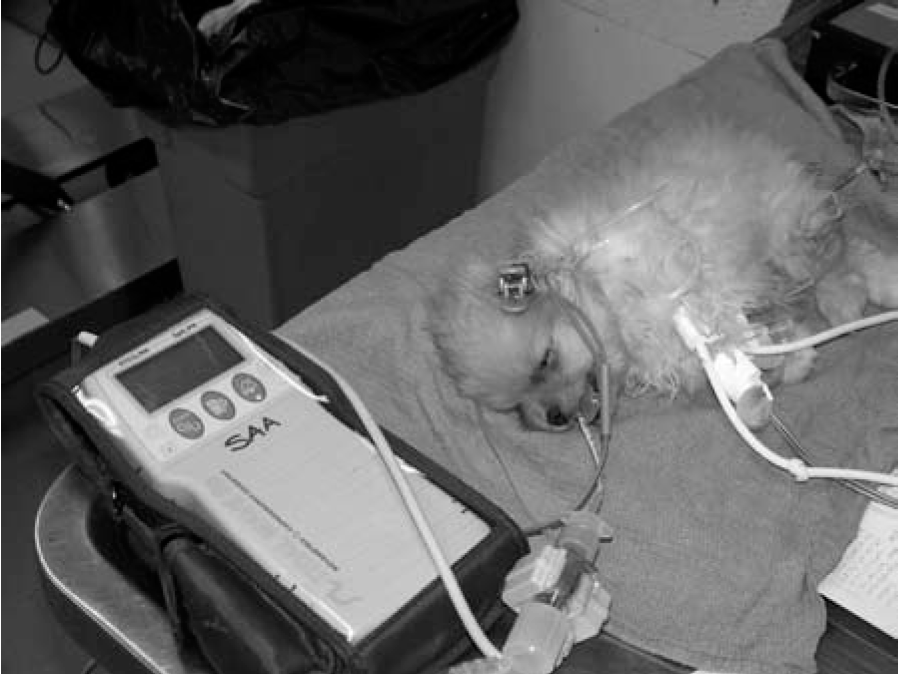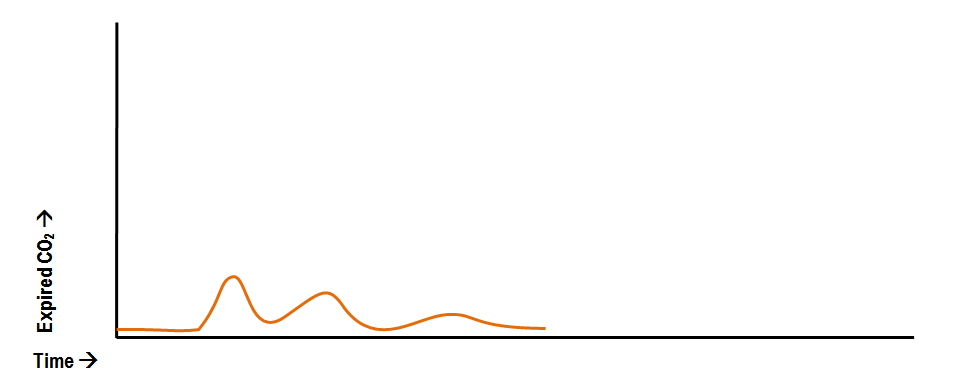normal end tidal co2 dog
Capnography waveforms etCO2 and breathing patterns. We know that elevated ETCO2 hypercapnia occurs during hypoventilation and a decrease in ETCO2 hypocapnia occurs with hyperventilation.

Learn More With This Respiratory Article By Melissa Marshall
Using Capnography During Anesthesia.

. Veterinary Specialist Services Veterinary Anesthesia. Anaesthesia of the dog Veterinary Anaesthesia Eleventh Edition. This is end-tidal CO 2 ETCO 2 which is normally 35 to 45 mm Hg in dogs and 28 to 32 mm Hg in cats.
The CO 2 waveform is a valuable tool for detecting leaks in the anesthetic system rebreathing of CO 2. Simultaneous comparison of heart rate ECG or stethoscope with pulse rate palpation or blood pressure monitor allows the anesthetist to pick up some dysrhythmias. According to the book by Hockenberry and Wilson 2015 p 1140 normal values of ETCO2 are 30-43 mmHg which is slightly lower than arterial PaCO2 35-45mmHg.
CO2 is produced in the tissues is carried by the vasculature and is eliminated by the lungs. Normal arterial blood pressure values for dogs and cats are indicated in Table 111. To determine whether the partial pressure of end-tidal carbon dioxide PetCO 2 could predict return of spontaneous circulation ROSC in patients with cardiopulmonary arrest CPA undergoing CPR.
Join us in this hour and learn about monitoring the patient undergoing anesthesia interpretation of end tidal carbon dioxide CO2 values and appropriate interventions for patients with abnormal values. Carbon dioxide is the end product of aerobic cellular metabolism the function of cells that require. The normal end-tidal capnography wave form is basically a rounded rectangle.
The normal levels of expired CO2 in dogs and cats should between 35 and 45 mm Hg millimeters of mercury. Airflow through the avian parabronchial lung is unidirectional which means all exhaled gases pass through the cranial air sacs and trachea without having a dilutional effect on end-tidal carbon dioxide. Hypercapnia in Dogs.
Most anesthetics are respiratory depressants and end-tidal CO2 allows early detection of respiratory impairment so. Heart rate can be monitored from an ECG from a stethoscope esophageal stethoscope pulse oximeter or blood pressure monitor. The measurement of end-tidal carbon dioxide ETCO 2 allows the continuous monitoring of the adequacy of ventilation and circulation in the anaesthetised patientIt measures inspired and expired carbon dioxide CO 2 throughout the whole respiratory cycle using infrared spectroscopyETCO 2 can be of value in the assessment of ventilation metabolism and of a.
Thirty-five client-owned dogs and cats in CPA in which CPR was performed. Therefore ETCO 2 generally exceeds PaCO 2 by approximately 5 mm Hg in birds. The end-tidal carbon dioxide tension PetCO2 measured after a single large tidal-volume breath 15 mlkg body weight was compared to simultaneous measurements of PaCO2 in 6 dogs with normal lungs who were receiving high-frequency jet ventilation HFJV.
Negative Epigastric sounds Equal lung sounds Esophageal detector. Hypercapnia is characterized by an increase in the partial pressure of carbon dioxide in the arterial blood. 48 When a person is breathing out CO 2 the graph goes up.
Login Email Password. Also called capnometry or capnography this noninvasive technique provides a breath-by-breath analysis and a continuous recording of ventilatory status. 4 to 5 CO2 PetCO2 vs.
There was an excellent linear correlation between PetCO2 and the PaCO2 over the entire range of CO2. Systole represents cardiac contraction and diastole occurs during cardiac filling. The mean arterial pressure MAP is determined by the following equation.
A more complete picture of carbon dioxide transfer can be obtained from a capnogram similar to an ECG tracing. 2 See Figure 1 p. Carbon dioxide during ventilation.
Throughout the breath cycle. End-tidal carbon dioxide EtCO 2. Carbon dioxide is a normal part of the atmosphere and a normal component of the chemical make-up of the mammalian body.
The capnograph is the waveform that shows how much CO 2 is present at each phase of the respiratory cycle and it normally has a rectangular shape Figure 1. End-tidal capnography or end-tidal CO2 EtCO2 monitoring is a non-invasive technique that measures the partial pressure or maximal concentration of carbon dioxide CO2 at the end of an exhaled breath. End-tidal carbon dioxide ETco 2 monitoring provides valuable information about CO 2 production and clearance ventilation.
PaCO2 PetCO2 End tidal measurement from expired or exhaled air PaCO2 Arterial blood gas sample End tidal normally 2-5 mmHg lower than arterial Comparing Arterial and End-tidal CO2 Review of Airway Confirmation Visualization Auscultation. 2 See Figure 1 p. Understand how capnography or end tidal CO2 helps to monitor integrity of airway cardiac output and CO2 production during anesthesia ACLS sedation emergency medicine prehospital arena intensive care units trauma and assess functionality of breathing circuits and ventilators.
The end-tidal level of carbon dioxide is generally less but is reflective of carbon dioxide in arterial blood and can serve as an indirect noninvasive method of assessing the adequacy ventilation. Pulse pressure is a result of the difference between the systolic and diastolic pressures. Keep me logged in.
Capnography can be used to measure end-tidal CO 2. Capnography also measures and displays the respiratory rate. Under most circumstances healthy pet no chest surgery end-tidal CO 2 is typically 5 10 mmHg less than arterial CO 2.
Since problems with lungs are not common and gas exchange between alveoli and the blood is swift and effective. In conditions of normal breathing 6 Lmin 12 breathsmin 500 ml for tidal volume etCO 2 is very close to alveolar CO2. This is end-tidal CO 2 ETCO 2 which is normally 35 to 45 mm Hg in dogs and 28 to 32 mm Hg in cats.
End-tidal CO 2 monitoring is a non-invasive means of estimating arterial CO 2. End-tidal carbon dioxide measurement allows non-invasive measurement of the ability of the respiratory system to excrete carbon dioxide usually indicative of respiratory function. Two private specialty referral hospitals.
End-tidal CO2 usually underestimates PaCO 2 by 2-5 mm Hg in mammals. This trace is considered to be normal 2. In fact its commonly called the ventilation vital sign.
Normal range is 35-45mmHg and roughly correlates with the partial pressure of CO2 in arterial blood remember that PaCO2 is usually slightly higher than ETCO2 by 2-5mmHg.

End Tidal Carbon Dioxide Tension Pet Co 2 In Normal Individuals Over Download Table

Pdf Capnography In Dogs Semantic Scholar

Capnography In Veterinary Medicine Chapter 28 Capnography

Learn More With This Respiratory Article By Melissa Marshall

Learn More With This Respiratory Article By Melissa Marshall

Pdf Capnography In Dogs Semantic Scholar

Learn More With This Respiratory Article By Melissa Marshall

Pdf Capnography In Dogs Semantic Scholar

Abnormal Capnography Waveforms And Their Interpretation Deranged Physiology

Learn More With This Respiratory Article By Melissa Marshall

Learn More With This Respiratory Article By Melissa Marshall

Pdf Capnography In Dogs Semantic Scholar

Veterinary Specialist Services Veterinary Anesthesia
Riding The Wave Of Capnography Understanding Etco2 Vetbloom Blog

Learn More With This Respiratory Article By Melissa Marshall
Did You Know Hypercapnia Is Synonymous With Hypoventilation
Riding The Wave Of Capnography Understanding Etco2 Vetbloom Blog
